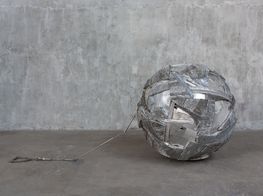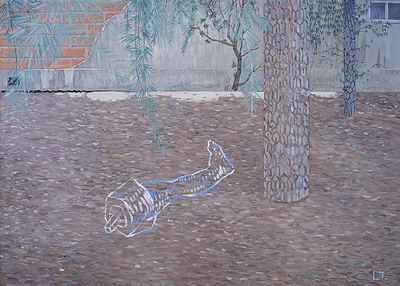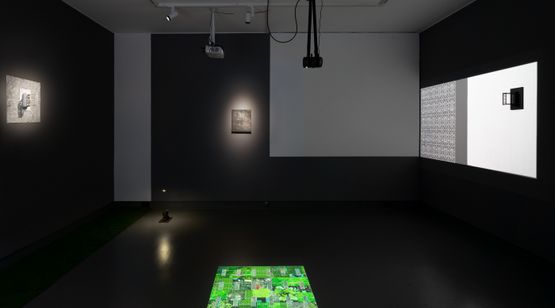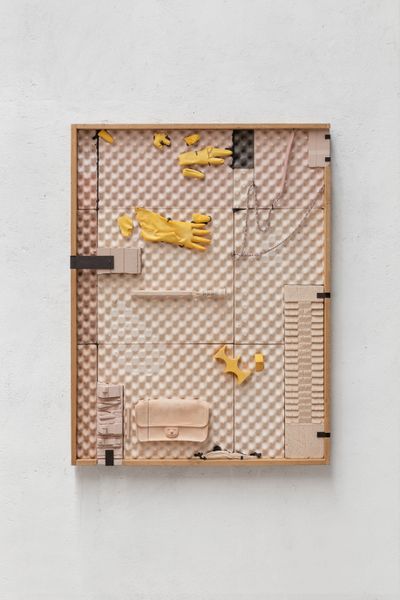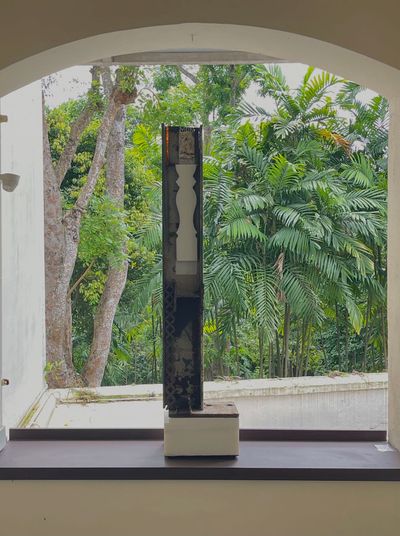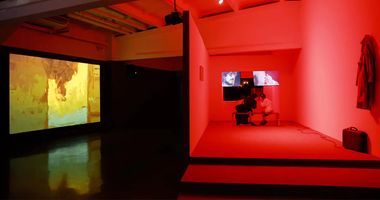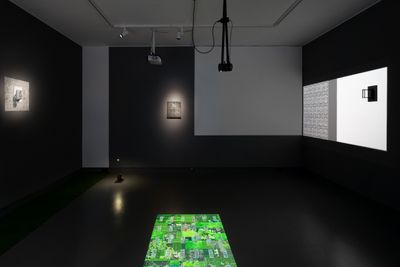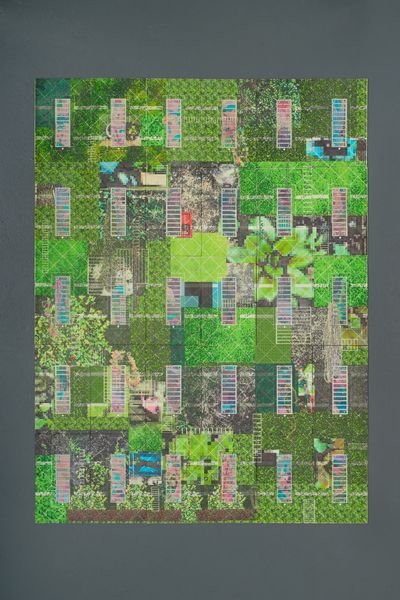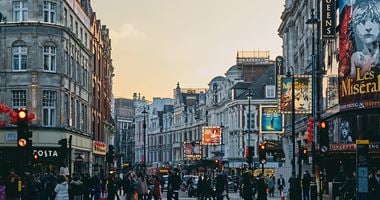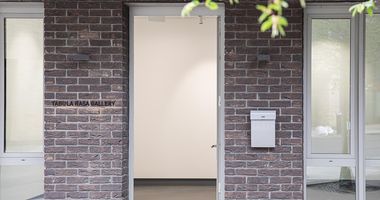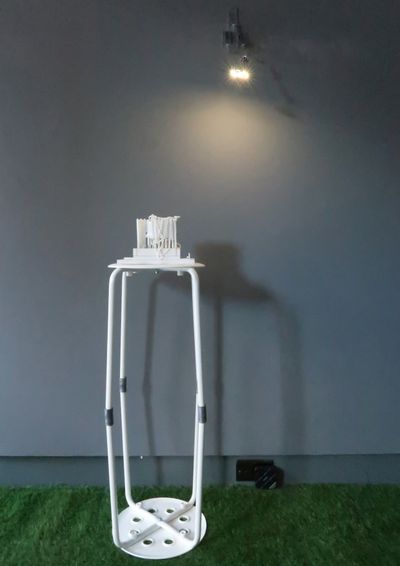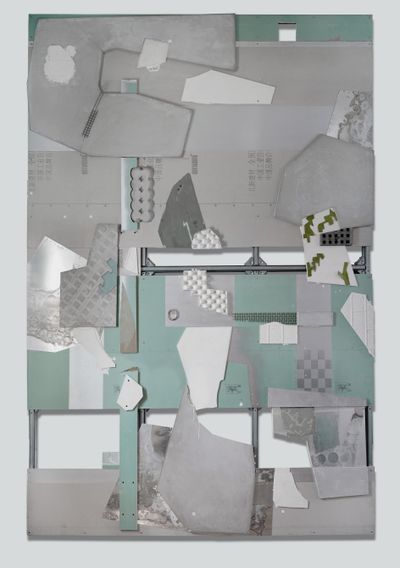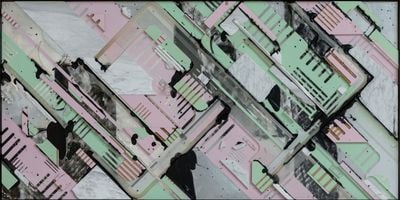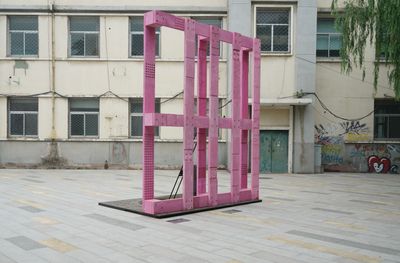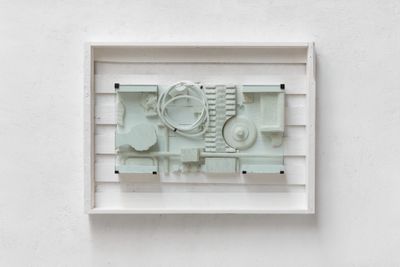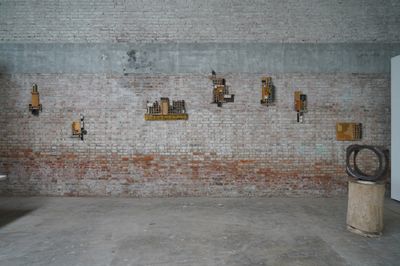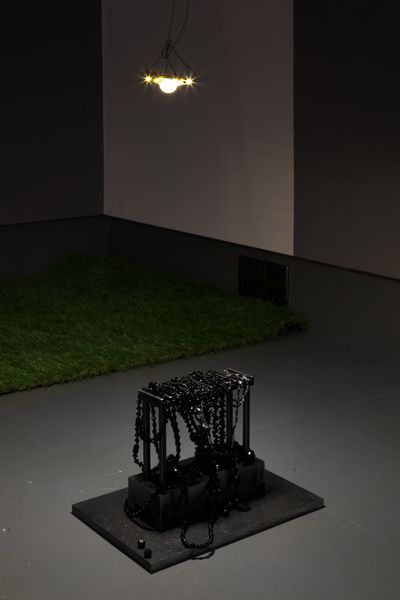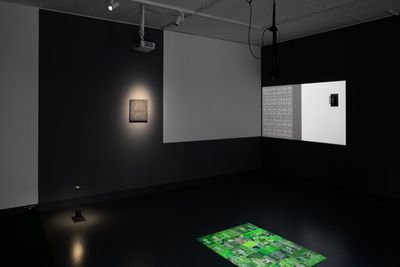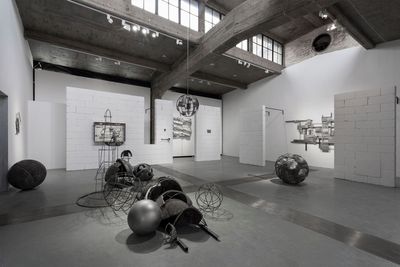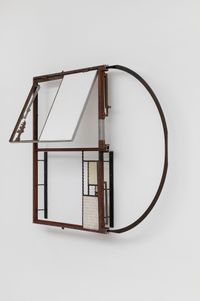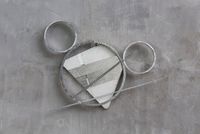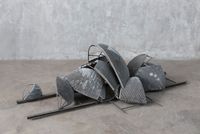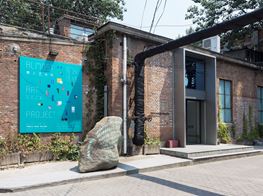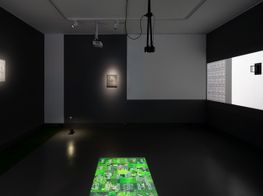Li Tao: Navigating 2.5 Dimensional Space
Sponsored Content | Tabula Rasa Gallery
Li Tao in his studio. Courtesy the artist.

Li Tao in his studio. Courtesy the artist.
Known for his alchemical manipulation of industrial materials into abstract forms, Beijing-based artist Li Tao has forged a dynamic and multidisciplinary artistic practice that spans over two decades.
The intricate layers of Li Tao's artworks are akin to his versatility beyond the art world. A graduate of Henan University (1995) and Hubei Academy of Fine Arts (1998), Li Tao spent years painting with a subdued palette on canvas, while working as a lecturer at the Animation Department of the Communication University of China. The artist also co-founded an advertising venture and took on architecture and interior design projects, including a role as the artistic consultant for the ongoing restoration of the stupa of the Buddhist Temple of King Ashoka in Ningbo.
Li Tao's wide-ranging experiences proved instrumental in shaping his artistic trajectory in subsequent years, when he veered away from traditional painting to delve into experiments that involved transforming and reconstructing various elements.
In the early 2010s, spatial explorations began to take centre-stage in Li Tao's work. Although the shift seemed to diverge from the path carved by his training in painting and printmaking, the artist regards his sculptural creations as 'sequential projections of flat shapes, layered to create a three-dimensional effect.' These collage experiments, usually taking the form of wall assemblages that interweave the two- and three- dimensional, have since become his hallmark.
Often operating with series, Li Tao seeks to exhaust all possible relationships between various forms and materials. An eclectic array of mediums—aluminium, wood, marble, and Polysulfone (PSU) engineering plastic—undergo a sequence of procedures in his work, including cutting, twisting, recombination, and welding. Results of this intense and even violent metamorphosis, juxtaposed with muted tone, offer a symphony of neutrality and alienation for the viewer.
In the series 'Archimedes' (2016) and 'Pengzhou Bubbles' (2020), Li Tao deviates from his signature greyscale and industrial aesthetic, merging elements of IKEA children's furniture with shades of baby pink and green. Along with delicately textured foam board shapes cast in plaster, the sculptural works subvert our perception of the familiar.
The pink hue gains a dramatic prominence in his monumental installation A shelf with one board missing (2021), featured in the public sector of this year's Gallery Weekend Beijing (26 May–4 June 2023). Originally a wooden underboarding plate that Li Tao enlarged and transformed into a high-strength concrete sculpture, the work was an incongruous presence against the backdrop of Soviet-style structures in the 798 Art District with its pink-and-purple colour palette.
In addition to showing in Gallery Weekend Beijing, the past year has been remarkably productive for Li Tao. A Week (2023), a group of freestanding sculptures made primarily from white marble and iron, was showcased at Emrald Hill in Singapore during Art SG (12–15 January 2023). Following a two-month residency in London, Li Tao held a solo exhibition in the city at Tabula Rasa Gallery, titled London Allotments (17 March–13 May 2023).
Using London's allotment system as a unique agency for framing his perceptions of the city, he created site-specific installations and sculptures that reflect the paradoxical nature of allotments—meticulously planned, identical urban spaces that foster ideas of idyllic pursuits and individual freedom.
In the following text, transcribed from a recent studio visit, Li Tao discusses the methodological, material, and colour spectral shifts evident in his latest projects. The dialogue offers an exploration of the artist's fascination with unravelling implicit contradictions within reality, artistic adaptation to the fluid dynamics of society, and his distinct approach to navigating the '2.5 dimensional space' both within his artworks and beyond.
SZLet's start with London Allotments, your solo exhibition at Tabula Rasa Gallery in London earlier this year. The project was conceived during your stay in the city when you spotted a community garden beneath a railway viaduct. This discovery piqued your interest in the history of allotments. Compared to your material experiments, London Allotments appears to signify a research-based methodology that is new in your practice. Would you say this shift was stimulated by your status as a foreigner and outsider in the city?
LTIndeed, in London, a sense of novelty and excitement struck me, and I soon realised it was about people, not just urban landscapes. I think even when an artist portrays landscapes or still life, the ultimate essence is rooted in understanding people, because art is intertwined with humanism. This sentiment holds true as I navigate through a city, captivated by its intricacies and diversity, both of which are manifestations of human activities.
However, being a newcomer in London with language barriers, I didn't establish deep connections with the locals nor was I particularly drawn to conducting some sociological surveys on-site. Instead, I was looking for a conduit that would bear the imprints and outcomes of their activities.
And so I encountered the allotments, an ideal intermediary for me. The allotment garden that instantly seized my attention is typical in London. It has a U-shaped layout, with its open side facing the viaduct, forming a semi-enclosed space, or an isolated landscape that grants fleeting glimpses from a passing train. Parcelled and designated to each household surrounding it, the garden fosters a mesh-like structure and an orderliness—attributes that I like to endow my own work with.
The contradictions intrinsic to these rectangular plots demarcated for distinct households also intrigued me. I can't help contemplating its manifestation of growth and vitality that, upon the removal of its verdure, instantly invokes the structured demeanour of a cemetery.
Another paradox lies in the idyllic symbol it represents: a semblance of government-offered liberty, yet constrained by regulations that dictate planting species and procedures while endeavouring to cultivate diversity. But when you view it from afar and above, this diversity diminishes, and the allotments converge into a collective portrait of the city.
SZYou turned Tabula Rasa Gallery into a darkened space where a flat, square, green digital image sprawled across the floor. Did this arrangement serve as a visual representation of the allotments you had been observing?
LTI'm not interested in representation or expression; rather, I'm inclined to showcase. This entails forging a parallel relationship between my observations and my creations. Upon entering the exhibition space, you gaze downward at this flattened image that looks like a view of the allotments from the viaduct. I meticulously planned a rectangular expanse measuring 1200 x 900 cm, in which images were juxtaposed precisely against each other, reminiscent of the sophisticated management and planning emblematic of a highly capitalised society. However, the execution of these plans are full of contingencies and impromptu solutions, an example of which is how people use or repurpose whatever at hand to tend to their allotments.
I'm drawn to a similar sense of improvisation in my own creative process. The floor piece has a deceitful or illusory quality in the way that it appears to be a projection, but it is in fact an illuminated digital print. Beyond this, a lot of elements in the space embrace a lack of refinement, from lights wrapped in tape to an economically fashioned sculpture base assembled from two stacked IKEA chairs.
Moreover, I'm intrigued by the idea of imbuing the exhibition space with an ambience that straddles the realms of an art venue and a highly commercial place. The works in the exhibition can be seen as parodies of real estate sales offices. There is a floor plan, assemblages reminiscent of showrooms, and a drawing in the style of sales graphics.
I wanted to create a dilapidated garden through the assemblages, but in the end I opted against literal depictions of ruins. Instead, I bought secondhand palettes and jewellery, coating them in black and white hues to evoke imagery of skeletal forms in graveyards. For me, these creations materialise as 'spiritual projections' of tangible objects.
SZYou used the word 'projection' and sometimes you use similar terms like 'photo' or 'sketch' to describe your installations and sculptures. Such phrasings evoke reflections of your academic foundation in oil painting and printmaking, which seems to contrast with your later interest in architectural design. This interplay between the two and three dimensions is notably manifest in your wall assemblages, which are richly layered while allowing frontal observation only. Could you elaborate on this?
LTA lot of my works are 2.5 dimensional and static in nature. I approach crafting wall assemblages in much the same way as I do two-dimensional works. Also, my freestanding sculptures don't quite feel like real sculptures to me, but more like sequential projections of flat shapes, layered to create a three-dimensional effect. When we talk about space, we usually mean a fluid, voluminous concept, like a vessel. But I prefer dealing with the surfaces.
My approach is not about creating traditional perspectives. Instead, I squash, overlap, and compress elements, pushing the foreground towards the back and squeezing surfaces together. In this process, something might disappear or get hidden. In this sense, the two-dimensional is illusionary, and I've always enjoyed working with illusion. However, some wall assemblages aren't complete on their own; they only fully come together once they're in the exhibition space. That's why I like making sketches specifically for my own exhibitions.
SZThat clarifies why you frequently reference painters, particularly those whose creations possess an unrefined, coarse quality marked by visible traces. Your own artworks also exhibit a speckled, weathered aesthetic replete with perforations.
LTIndeed, I've drawn inspiration from the work of artists like Jasper Johns and Rudolf Stingel. Their canvases exude a raw, chaotic aura, almost as if the paint staggers and tumbles over the surface. Even the architects who captivate me are those who exhibit a keen sensitivity to flat planes, including Aldo Rossi, James Sterling, and Michael Graves, the architect behind the Portland City Hall design.
SZYet some of your works also incorporate vibrant colours. Take, for instance, the peculiar and unsettling pink hue that dominates A shelf with one board missing (2021), a monumental installation featured in this year's Gallery Weekend Beijing. Could you elaborate on using this particular colour?
LTWhen I started painting in the 1990s, I'd use any colour at hand. I refer to that phase as my 'inherent colour period', when my work faithfully mirrored the colours of the real world. Between 2009 and 2019, I refrained from using colour, a period during which I started integrating industrial materials like aluminium into my work without altering their inherent colours.
Around 2020, with the inception of the 'Pengzhou Bubbles' series, I rekindled my engagement with colour, employing shades like pink and green from IKEA children's furniture to craft collages. I don't think there's a precise reason behind my choice of colour. I would instinctively avoid a certain realm of colours, such as some of the dominant colours or those that might convey strong associations.
Unlike the naturalistic hues in 'Pengzhou Bubbles', the pinkish-purple colour in A shelf with one board missing doesn't lean to any specific interpretation. I like how it maintains a separation from any other colour and allows the materials and textures to communicate their own narrative.
SZThe details in your work are both elusive and compelling. Sometimes found objects undergo a process of deconstruction and reconstruction, while in other cases, elements that appear as found objects are, in fact, crafted by your own hand. I'm curious about the process your materials go through before they come into a final composition?
LTPerhaps we could use the series currently in front of us in the studio as an example. These pieces are not yet finished, and may be regarded as preliminary studies.
Some of the main materials here are windows sourced from ancient Chinese architecture, which underwent three phases of deformation. They were already slightly broken when I collected them, but the structure was intact. I didn't store them carefully, leading them to be exposing them to sunlight and rain for a long time. Consequently, I had to make strategic cuts to the windows—that's the second phase. Finally, I combined these vestiges of the windows with wooden panels coated with resin, and yellow synthetic resin grills I made myself. I intentionally employed two different types of resin, one extracted from plants, looking natural and crystallised, and the other industrially produced with a modern, sleek appearance.
I fused all these materials together using the traditional technique of mortise-and-tenon joinery. Ultimately, these materials form diverse relationships among themselves, be it nested, interlocked, or mutually exclusive.
SZYou previously taught in the Animation Department at the Communication University of China, co-founded an advertising agency, and have been working in architectural and interior design. How have these experiences influenced your artistic practice?
LTThese three jobs have indeed influenced different aspects of my art practice. Teaching graphic manipulation at college shifted my approach to dealing with elements in my art, emphasising a more fluid process compared to traditional painting's flat, one-off result. With the computer, you can effortlessly deconstruct graphics and manipulate them across files, and all your actions are reversible and traceable.
Additionally, my work in the ad agency, where I focused on how the public visually engages with the content, has subtly influenced my artistic considerations. Although I strive to keep my art self-contained, I must admit that some strategies of navigating the audience through my exhibitions, as seen in London Allotments, might have been shaped by this experience.
Architecture and interior design are more like a joint connecting myself and the outside world, because the work is always assigned or commissioned by others. In this case, working with an external goal is very different from working for myself, and provides some fresh air. In addition, this kind of work requires you to constantly study the current trends, and you'll have to frequently go to places like IKEA, Uniqlo, and building material markets, in order to find out what materials, colours, styles, and patterns are popular nowadays.
SZYou once mentioned that your work 'presents a sense of unbiased neutrality.' But I know that you are often drawn to the news and international events. Some of your works from 2015 are also among your most personal creations, such The King of Qi and Ventilator, that incorporated copper tubes reminiscent of vasculature and were sparked by seeing your family fall ill. Would you say that works such as these reveal the emotional aspect of your practice?
LTThere was a long time when art was a tool for self-communication and self-balancing for me, rather than a means to impress or persuade others. When I was grappling with personal turmoil, I chose to work in the opposite way which allows minimal flexibility. Therefore, the work could be seen as a by-product of my inner dialogues and my attempt to restore equilibrium.
I'm drawn to the sentimental. For me, emotions and complexity are always intertwined. A pristine billboard or a freshly tended vegetable garden never stirs up any feelings in me, but once the billboard is defaced or the garden becomes cluttered, they capture my attention. Exposure to various forms of chaotic information holds great significance for me, prompting me to reflect on all my life experiences to respond. However, I'm not the type of artist who directly conveys emotions, as I also retain doubts about my sentiments or judgments. I prefer a discreet, suggestive approach.
SZIn contrast to your description of being 'discreet' or 'suggestive', your studio looks like a factory, and your process is full of vigorous actions such as cutting, drilling, and welding. Known examples are 'Universe' and 'Wave Board' series (both 2019), in which you use heat sinks salvaged from car accidents. What does this violence mean to you?
LTAn implicit metaphor lies beneath the surface here. There's something rigorous in my practice that deviates from conventional art-making in that it doesn't provide avenues for seeking release, solace, or care. Rather, it's somewhat oppressive, resembling a parallel to our harsh reality.
This aligns with my earlier mention of tragedy. I find myself compelled to create art when reality stimulates or overwhelms me to a certain extent. You just have to go for it. I always believe that artists have two parallel destinies: as an artist I get invigorated and even enthused by tragedies, but as an ordinary individual, I'm submerged in empathy and sorrow. These dual destinies interweave in me as I navigate between sentimentality and rationality. —[O]

